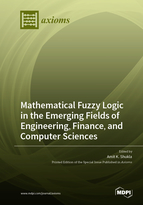Mathematical Fuzzy Logic in the Emerging Fields of Engineering, Finance, and Computer Sciences
A special issue of Axioms (ISSN 2075-1680). This special issue belongs to the section "Logic".
Deadline for manuscript submissions: closed (10 July 2022) | Viewed by 41321
Please contact the Guest Editor or the Journal Editor (alex.zhang@mdpi.com) for any queries about the scope, discount, submission procedure and publication process.
Special Issue Editor
Interests: computational intelligence; fuzzy sets; industry 4.0; transfer learning anomaly detection
Special Issues, Collections and Topics in MDPI journals
Special Issue Information
Dear Colleagues,
With more than 50 years of literature, fuzzy logic has gradually progressed from an emerging field to a developed research domain, encompassing the subdomain of mathematical fuzzy logic (MFL) which targets the many-valued logics and has significantly contributed to the logical foundations of fuzzy set theory (FST). Indeed, thanks to the strong interest from researchers, the literature on the modelling and theory of MFL has expanded rapidly, improving our understanding of this domain and enabling to target a wide range of complex problems in many applicative contexts ranging from the medical sciences to finance, commerce, engineering, and computer sciences.
However, more attention is required from the research community, especially in the current context in which data-driven information retrieval and explainability are of great concern with the growth of never-ending data resources. Moreover, this field also holds significance in the framework of artificial intelligence and deep learning. Therefore, this Special Issue aims to collect papers on the cutting-edge contributions of MFL to the emerging fields of engineering, finance, and computer sciences. We encourage you to submit your original research articles and reviews. Research areas may include (but are not limited to) the following:
- Uncertainty modeling with MFL;
- MFL and FST in engineering;
- MFL and FST for finance;
- MFL and FST for computer sciences;
- MFL and FST for Industry 4.0;
- MFL and FST in image processing;
- MFL and FST for cyber security;
- MFL and FST for medical sciences (COVID-19, etc.);
- MFL and FST in energy optimization issues;
- Other application areas
Dr. Amit Shukla
Guest Editor
Manuscript Submission Information
Manuscripts should be submitted online at www.mdpi.com by registering and logging in to this website. Once you are registered, click here to go to the submission form. Manuscripts can be submitted until the deadline. All submissions that pass pre-check are peer-reviewed. Accepted papers will be published continuously in the journal (as soon as accepted) and will be listed together on the special issue website. Research articles, review articles as well as short communications are invited. For planned papers, a title and short abstract (about 100 words) can be sent to the Editorial Office for announcement on this website.
Submitted manuscripts should not have been published previously, nor be under consideration for publication elsewhere (except conference proceedings papers). All manuscripts are thoroughly refereed through a single-blind peer-review process. A guide for authors and other relevant information for submission of manuscripts is available on the Instructions for Authors page. Axioms is an international peer-reviewed open access monthly journal published by MDPI.
Please visit the Instructions for Authors page before submitting a manuscript. The Article Processing Charge (APC) for publication in this open access journal is 2400 CHF (Swiss Francs). Submitted papers should be well formatted and use good English. Authors may use MDPI's English editing service prior to publication or during author revisions.
Keywords
- fuzzy logic
- fuzzy set theory
- computer science
- engineering
- artificial intelligence





